Related Research Articles
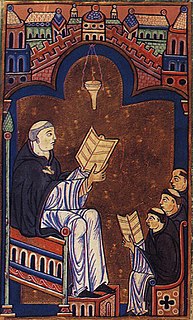
Richard of Saint Victor was a Medieval Scottish philosopher and theologian and one of the most influential religious thinkers of his time. A canon regular, he was a prominent mystical theologian, and was prior of the famous Augustinian Abbey of Saint Victor in Paris from 1162 until his death in 1173.
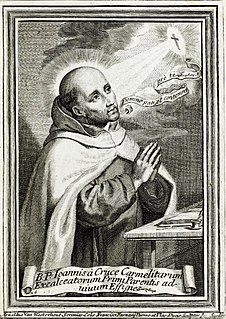
John of the Cross, venerated as Saint John of the Cross, was a Spanish Catholic priest, mystic, and a Carmelite friar of converso origin. He is a major figure of the Counter-Reformation in Spain, and he is one of the thirty-six Doctors of the Church.

Vulcano or Vulcan is a small volcanic island in the Tyrrhenian Sea, about 25 km (16 mi) north of Sicily and located at the southernmost end of the seven Aeolian Islands. The island is 21 km2 (8 sq mi) in area, rises to 501 m (1,644 ft) above sea level, and it contains several volcanic calderas, including one of the four active volcanoes in Italy that are not submarine.
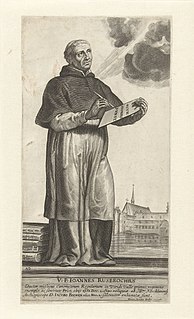
John van Ruysbroeck, original Flemish name Jan van Ruusbroec was an Augustinian canon and one of the most important of the Flemish mystics. Some of his main literary works include The Kingdom of the Divine Lovers, The Twelve Beguines, The Spiritual Espousals, A Mirror of Eternal Blessedness, The Little Book of Enlightenment, and The Sparkling Stone. Some of his letters also survive, as well as several short sayings. He wrote in the Dutch vernacular, the language of the common people of the Low Countries, rather than in Latin, the language of the Catholic Church liturgy and official texts, in order to reach a wider audience.
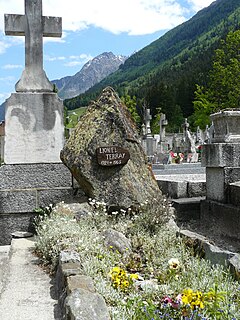
Lionel Terray was a French climber who made many first ascents, including on the 1955 French Makalu expedition in the Himalaya and Cerro Fitz Roy in the Patagonian Andes.
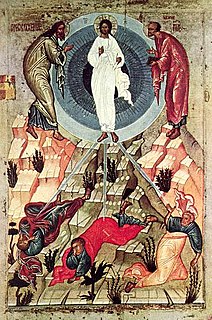
Dark Night of the Soul is a poem written by the 16th-century Spanish mystic and poet St. John of the Cross. The author himself did not give any title to his poem, on which he wrote two book-length commentaries: Ascent of Mount Carmel and The Dark Night.

Monte Fitz Roy is a mountain in Patagonia, on the border between Argentina and Chile. It is located in the Southern Patagonian Ice Field, near El Chaltén village and Viedma Lake. It was first climbed in 1952 by French alpinists Lionel Terray and Guido Magnone.
Eric Earle Shipton, CBE, was an English Himalayan mountaineer.

Federico Commandino was an Italian humanist and mathematician.
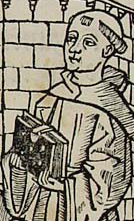
Francesc Eiximenis, OFM was a Franciscan Catalan writer who lived in the 14th-century Crown of Aragon. He was possibly one of the more successful medieval Catalan writers, since his works were widely read, copied, published and translated. Therefore, it can be said that both in the literary and in the political sphere he had a lot of influence. Among his readers were numbered important people of his time, such as the kings of the Crown of Aragon Peter IV, John I and Martin I, the queen Maria de Luna, and the Pope of Avignon Benedict XIII.

Nicolás Bautista Monardes was a Spanish physician and botanist.

Ascent of Mount Carmel is a 16th-century spiritual treatise by Spanish Catholic mystic and poet Saint John of the Cross. The book is a systematic treatment of the ascetical life in pursuit of mystical union with Christ, giving advice and reporting on his own experience. Alongside another connected work by John, entitled The Dark Night, it details the so-called Dark Night of the Soul, when the individual Soul undergoes earthly and spiritual privations in search of union with God. These two works, together with John's The Living Flame of Love and the Spiritual Canticle, are regarded as some of the greatest works both in Christian mysticism and in the Spanish language.
In Christian theology, cardiognosis is a special charism that God confers on some saints. In Christian asceticism, the term Cardiognosis also indicates the ascetical methods and meditation techniques which have the purpose of reaching an inner state of mystical experience and, eventually, the charisma of Cardiognosis.

The Lives of the Most Excellent Painters, Sculptors, and Architects, often simply known as The Lives, is a series of artist biographies written by 16th-century Italian painter and architect Giorgio Vasari, which is considered "perhaps the most famous, and even today the most-read work of the older literature of art", "some of the Italian Renaissance's most influential writing on art", and "the first important book on art history".

Burchard of Mount Sion, was a German priest, Dominican friar, pilgrim and author probably from Magdeburg in northern Germany, who travelled to the Middle East at the end of the 13th century. There he wrote his book called: Descriptio Terrae Sanctae or "Description of the Holy Land" which is considered to be of "extraordinary importance".

No Picnic on Mount Kenya by Felice Benuzzi is a mountaineering classic recounting the 1943 attempt of three escaped Italian prisoners of war to reach the summit of Mount Kenya. It was first published in 1946 in English and 1947 in Italian. The 1994 film The Ascent is based on this book.
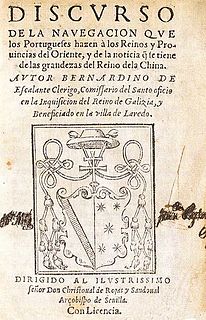
Bernardino de Escalante was a Spanish soldier, priest, geographer and a prolific writer. He is best known as the author of the second book on China that was published in Europe, and the first author of such a book to obtain wide circulation outside of Portugal.
Guigo de Ponte, also known as Guigues du Pont, was a Carthusian monk of the Grande Chartreuse. Little is known about him, but he probably professed there in 1271, and died in 1297.

Marco Antonio Montes de Oca was a Mexican poet and painter.
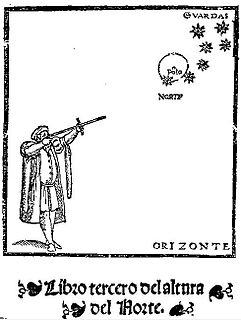
Pedro de Medina was a Spanish cartographer and author of navigational texts. His well-known Arte de navegar was the first work published in Spain dealing exclusively with navigational techniques.
References
- 1 2 3 Bernardino de Laredo, The ascent of Mount Sion: being the third book of the treatise of that name, translated with an introd. and notes by E. Allison Peers, (London: Faber & Faber, 1952), p12
- 1 2 "Fray Bernardino de Laredo, un místico franciscano a los pies de la Divina Pastora".
- ↑ A. Alonso González et al (eds), Subida del Monte Sión, (Madrid: Fundación Universitaria Española, Universidad Pontificia de Salamanca, 2000), p10. Gonzalez states that just the 1522 edition remains, in a unique copy in Madrid. Apparently Bartoleme Jose Gallardo (1888) attests to the existence of a second edition, but this has not been found), published anonymously but with enough internal evidence that scholars are sure of its attribution to Laredo,((5) p10)
- 1 2 3 4 es:Bernardino de laredo
- ↑ Bernardino de Laredo, The ascent of Mount Sion: being the third book of the treatise of that name, translated with an introd. and notes by E. Allison Peers, (London: Faber & Faber, 1952), p17
- ↑ Bernardino de Laredo, The ascent of Mount Sion: being the third book of the treatise of that name, translated with an introd. and notes by E. Allison Peers, (London: Faber & Faber, 1952), p44
- ↑ Bernardino de Laredo, The ascent of Mount Sion: being the third book of the treatise of that name, translated with an introd. and notes by E. Allison Peers, (London: Faber & Faber, 1952), p45
- ↑ Teresa of Ávila, Life, chapter XXIII
- ↑ P Ros, Un Inspirateur de Sainte Therese: Le Frere Bernardin de Laredo, (Paris, 1948), pp322-4, quoted in Bernardino de Laredo, The ascent of Mount Sion: being the third book of the treatise of that name, translated with an introd. and notes by E. Allison Peers, (London: Faber & Faber, 1952), p53